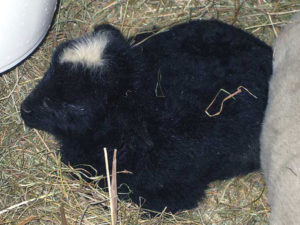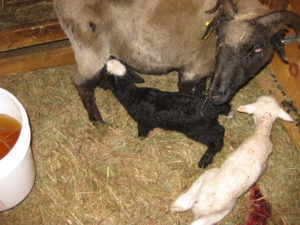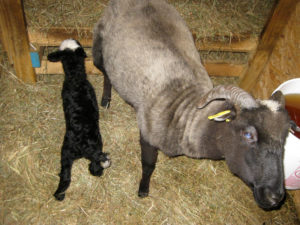
After weeks of preparation, and what felt like eons of waiting, our first lamb arrived on March 31, 2010, in the wee small hours of the morning. We knew the lambs could be born anytime after March 25, but weren’t sure exactly when they would show up. Zinnia, one of our four “first-timers” delivered all by herself and her strong, healthy ewe lamb was dry, up and walking when we found them early in the morning. A few days passed, Zinnia and her baby bonded in the jug, and we kept trying to predict when the next ewe would go for it.
Turns out, it was a family affair, with Aretha and Nina (a mother and her daughter from 2008) both delivering early this morning. Aretha gave birth to twin ewe lambs, a yin-yang pair in black and white. Nina had a single ram lamb, our first ram so far.

Mother and daughter are in their jugs with their lambs, bonding and resting after what must have been an exhausting morning. Tomorrow morning we’ll band the tails and put ear tags on these lambs and within another day or so they will rejoin the flock.
It’s been interesting to note the color patterns that we’re seeing so far. Our flock sire this year is predominantly cream with a few spots of light brown. Three out of four of his offspring have been black with white spots on their heads and white tail tips. The double white spot is a fairly common marking in the Navajo-Churro breed, called “two gray hills”.
The fourth lamb is the opposite, a solid white ewe. I’m hoping to cultivate some browns in our flock, and it’s possible that some of these black lambs will turn brown eventually, or they could go gray or silver. It is rare that a black lamb will stay solid jet black for more than a year; their fleece tends to bleach to a lighter color in the sun.

Meanwhile, we have three more pregnant ewes still waiting to deliver. I just hope all of their births are as easy as the others have been this year.

pam
April 5, 2010 at 8:09 amCongratulations. This is so cool- baby lambs in assorted colors!
amy
April 8, 2010 at 9:21 amThat Two Gray Hills coloring is interesting! So funny it’s on three new lambs. Is it going to be hard to tell some of them apart?
Hoping the rest of the lambing going successfully! 🙂
Sarah
April 9, 2010 at 4:37 pmYes, it’s tricky to tell the three black lambs apart. Zinnia’s lamb is larger than the other two so pretty easy to pick her out even from a distance. But this is just one reason that we put in ear tags – it’s easy to tell who’s who. (We also put the tags in to identify these as bred on our farm.) We use the tags to track a variety of traits. The ram lamb for example has a green ear tag while the ewes have yellow tags. This makes it easier to tell sex from a distance without having to bend down to check the “plumbing”. We also use the tags to designate whether a lamb was from a single or multiple birth. Twins (or triplets) wear their farm tag in their left ear. Single lambs wear the farm tag in the right. Because prolificacy is a heritable trait we keep track of this in addition to birth color, birth weight, and sire/dam.
john tischer
April 10, 2010 at 11:46 amLooks like the lambing is going well! Good luck with the rest of them! Dad
amy
April 13, 2010 at 2:23 pmI’m ready to hear more about the newest lambs! Pretty please 🙂
I saw Rick’s pics on Flickr. What happened with a brown twin- did the mother reject her? Sad 🙁
pam
April 25, 2010 at 5:14 pmI want the little white one!